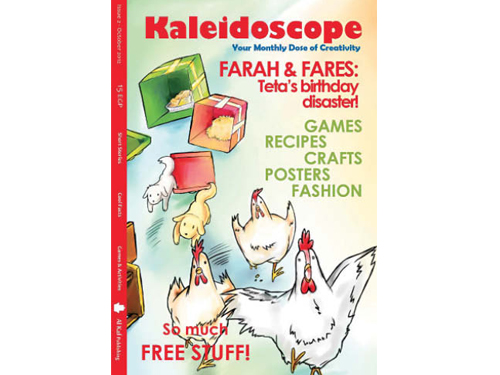
Dina Elabd is a soft-spoken 22-year-old with an impressive, goal-driven vision. She’s tall with a surprisingly composed demeanor — one usually established with age and experience.
Despite her unseasoned age, this young entrepreneur knows what she loves, and what she values in life.
“I have always loved education,” Elabd says, “always been really passionate about this. So I’ve taken the first step, and I definitely want to continue in that direction, whether through this project or through something else.”
The project is Kaleidoscope children’s magazine, which targets those aged 10 to 14 — specifically those who attend English-language schools. The first issue was distributed for free in bookstores, cafes, school bookstores and fast-food outlets.
The magazine will be sold for a small fee by the second issue and subscriptions are also offered.
“There needs to be income for growth. I don’t want to keep it small; I want it to grow,” she says.
Kaleidoscope is an initiative undertaken by Elabd and a few university colleagues.
“Everyone working on this is Egyptian,” she proudly proclaims. “I feel bad that there is so much imported media. Particularly anything in English, you have to get from abroad, and there’s so much talent here, so I’m glad that this magazine is a platform for that.”
The mechanical engineering major also has a minor in literature. It was in her literature classes that she met other writers and that is where the spark ignited.
Elabd and her colleagues spearheaded a children’s magazine aimed at “stimulating creativity and imagination.” After months of research, and finding a lack of a locally produced children’s English-language magazine in the market, Kaleidoscope was created.
“Our magazine is less expensive than books, so that’s a plus for parents. Plus it is produced monthly, so you can rely on continuity,” explains Elabd.
The publication is designed to appeal to different interests.
“Some readers like pictures and drawings, others like the way words play out, and some may like a certain character and will follow them. It’s different for everyone, so I try to create diversity in the magazine — hence the name Kaleidoscope,” she says.
It’s not every day that you find a university senior interested in children’s education, but Elabd thinks it runs in her family. Her mother owns a nursery where Elabd has often helped out with story time and playtime.
“I love kids,” she says. “I like talking to them and connecting with them on an equal level.”
Combining her passion for writing and her love of children has resulted in a magazine that has been more than well-received by parents. Elabd has been receiving glorious reviews and words of encouragement from parents of children who become engaged with the publication.
Among her literature classes at the American University in Cairo was a children’s literature class. There, Elabd learned about books written for children, children’s psychology and how to write for children.
“Most children feel betrayed by an author if there isn’t a moral in the end — not necessarily one that is spelled out, but they like to feel there’s a point in the end to why the protagonist did what they did,” Elabd says, drawing on her experiences working with children.
Kaleidoscope begins with two short stories.
“The whole point of the magazine is short stories,” says Elabd. “I really, really believe in reading.”
The first short story varies in each issue, but the second is part of a series titled “Farah & Fares,” written by Elabd herself. The series is about Egyptian siblings who live in Mohandiseen.
In the magazine’s first issue, “The History of Chocolate” inaugurates the history section. Certain words are highlighted in red, and are to be used in the word search accompanying the article.
Elabd is determined to make the magazine interactive, which is why she has included a word games section. She also intends for it to improve children’s vocabulary.
The magazine’s “Try It” section offers readers different activities, such as recipes, arts and crafts, fashion, sports and science experiments.
Children are also encouraged to contribute to the magazine. They can send stories, drawings or pictures of activities they have attempted from “Try It.”
“When we publish the readers’ contributions in upcoming issues, they can feel proud of themselves,” Elabd says.
The magazine includes film and book reviews, with books provided by Diwan Bookstores, followed by two advice columns written by doctors, including one by a psychologist who answers young readers’ questions.
“This section gives the magazine credibility, and it also offers important advice for parents,” says Elabd.
Elabd has also organized a tour to promote the magazine, offering children free activities including a crafts class taught by Dalia Rizkallah at Diwan, ballet and budokon classes at Fitstop, and a fashion class at Challenger Activity Center.
Leaving no opportunity unexploited, this entrepreneur has also included coupons on the last page of every issue. They can only be used by subscribers, who receive their own coupon card with their subscription.
The magazine’s partners offer coupons for free cupcakes, a free art class and a free dance class, among others.
Not many 22-year-olds would brave the bureaucratic aggravation of setting up a legitimate business, but Elabd had the support of some very sharp lawyers. Despite how time-consuming it was, she said it was worth the hassle in the end because of her intense passion for children and their education.
“I feel very sorry for children in our schools,” she says fervently. “There is such a lack of focus on the arts and on creativity — on just what kids like!”
As Elabd perseveres with her first initiative in empowering children’s creativity and imagination, she hopes to one day conduct her own research within the magazine’s target market. She has a hunger to get to know her readers more — who they are and what they like — and a hunger to fulfill all their creative and artistic needs.
Despite how large a feat this may be, Elabd is not daunted one bit by it.
“It has to be addressed,” she asserts, “it just has to.”
This article appeared in Egypt Independent's print edition




